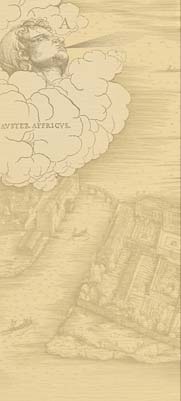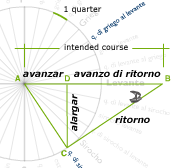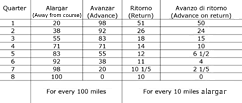Navigation: Toolkit
Recovering a Course
Ships were frequently blown off course. A standard problem for mariners was to recover their intended course. Michael demonstrates how to do this using the marteloio.
First he states the problem (![]() 47b):
47b):
"I want to sail levante, but I sail 100 miles sirocho al ostro. How many miles do I want to sail by griego al levante to come back to my course, and how far will I have advanced?"
For this problem, it is helpful to remember that the quarter of sirocho al ostro (southeast by south) is 5 quarters off the intended course, and the quarter of griego al levante (northeast by east) is 3 quarters off the intended course.
-
a) The ritorno
Michael's first goal is to calculate the ritorno (CB). He has a rule for this that uses values from the marteloio table.

The multiplication must be divided by 10 because the value for the ritorno in the table is given for every 10 miles that a ship is off course.
To make the calculation:
-
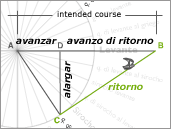
1] Michael takes the values he needs from the table. Since he sailed 100 miles on his first wind of 5 quarters, the alargar is 83. The ritorno for 3 quarters is 18.
-
2] He now calculates the actual ritorno (CB):

He would have to sail 149
 miles by griego al levante to get back to his original course to the east.
miles by griego al levante to get back to his original course to the east.
-
-
b) The avanzar
Michael's second goal is to calculate how far he would have advanced toward the destination by the time he recovered his course. This means he has to add the avanzar (AD) to the avanzo di ritorno (DB). He has a rule for calculating the avanzo di ritorno.

To make the calculation:
-
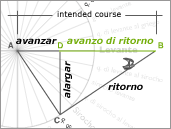
1] Michael takes the values from his table. Since he traveled 100 miles on the fifth quarter wind, the alargar is 83. The avanzo di ritorno for the second wind (CB) of 3 quarters is 15.
-
2] He can now calculate the actual avanzo di ritorno:

He would have advanced 124
 miles by his second wind.
miles by his second wind. -
3] Michael can take the initial avanzar from the table. Since he traveled 100 miles on the first fifth quarter wind, the value is 55, which he adds to the distance he already calculated for the avanzo di ritorno:

So Michael would have sailed 179
 miles toward his destination by the time he recovered his course.
miles toward his destination by the time he recovered his course.
-
-
c) Using the rule of three
Michael made this problem easier by choosing a distance of 100 miles for the first leg of his journey. This meant he could simply take the value for the alargar of 5 quarters from his table.
If he sailed a different distance on that wind, he could easily determine the resulting alargar by the rule of three.
For example, using modern notation, if Michael sailed 70 miles, then the alargar x could be found by:

The solution would be:

All Michael had to do was use 58
 miles as the value for alargar in his two rules.
miles as the value for alargar in his two rules.
See how Michael deals with multiple course changes or plots a course in advance.











